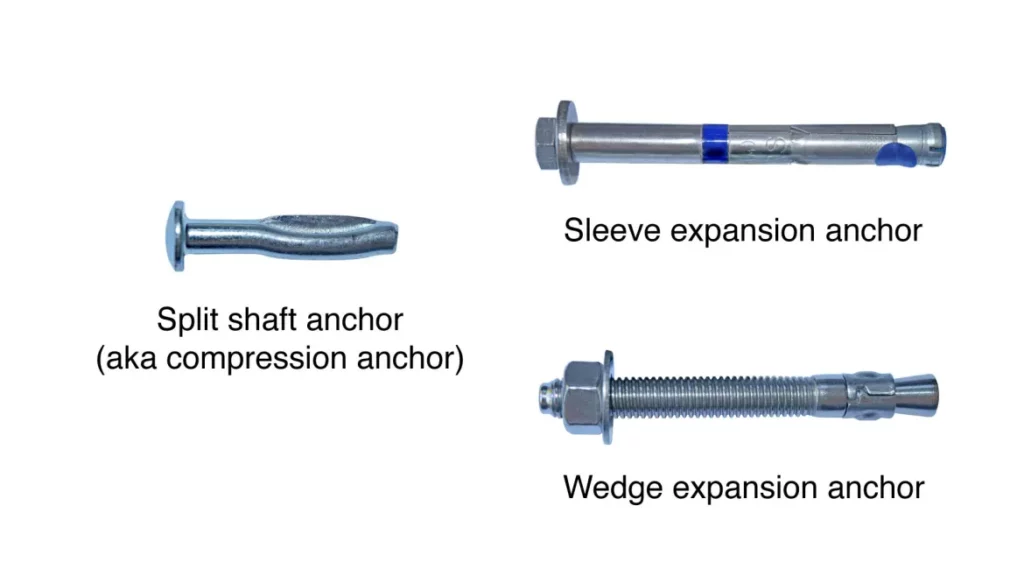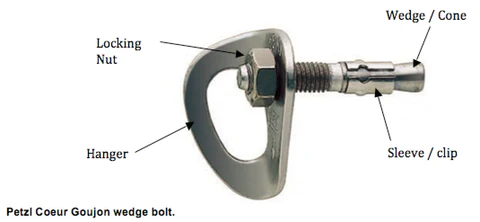Bolts are a continually evolving part of rock climbing. They are placed in the rock to help keep you safe, but how safe are they? How strong are rock climbing bolts? How often do climbing bolts fail?
If you have ever had questions about bolts, we are here to help! We’re here to answer your burning questions about rock climbing bolts. From explaining the main types of bolts to helping give you the tools to determine if a bolt is safe, we will cover it all.
 What are the Different Types of Climbing Bolts?
What are the Different Types of Climbing Bolts?
Expansion bolts, compression bolts, and glue-in bolts have all been used in different scenarios and at different points in time throughout climbing’s history. Although different bolt manufacturers will make bolts that look different, there are three main types of bolts. Here are the basics on these three bolt types:
Compression bolts
The photo on the left is a compression bolt. These bolts are typically older and will likely appear very rusted. They are easy to identify due to the smooth button-like appearance of the bolt head and are not considered to be good bolts.
They work by relying on the density of the rock to compress the wider part of the bolt. These bolts are bad in soft rocks, such as sandstone or limestone, that don’t have the density to compress the bolt.
Expansion bolts
As a category, expansion bolts are pretty extensive. They can look vastly different depending on the manufacturer and when they were made. These bolts work by the cone at the end, getting caught and held by the rock while the bolt itself pushes the sleeve farther down the cone, thus expanding it to fill the space.
Unlike compression bolts that rely on just the inward pressure from the density of the rock, expansion bolts rely on the inward pressure from the rock and the outward pressure on the rock created by the expanding sleeve. These bolts were super popular for a while and are still common in granite. They are not quite as reliable in softer rocks since the rock doesn’t have as much density to them.
Glue-in Bolts
The final category of bolts is the glue-in bolts. These bolts rely on glue to hold onto the bolt’s ridges, features, and the rock’s inside. These bolts are becoming more and more common since they don’t rely on the density of the rock, thus making them much more versatile.
The main challenge with glue-in bolts is the cost. These bolts are more expensive to buy and take more time to install than expansion bolts. However, they are a great option for softer rocks and are becoming increasingly popular in climbing areas with sandstone or limestone.
 How Long Do Climbing Bolts Last?
How Long Do Climbing Bolts Last?
No bolt was specifically made for rock climbing until Metolius started creating climbing bolts in the 1980s. Before that, people were using bolts from the hardware store to bolt routes, meaning that the bolts were designed for other intended uses. Since climbing-specific bolts haven’t really had that long to develop, there are still lots of iterations out there and lots more coming out each year.
All that means is that each bolt will last a different amount of time depending on the type of bolt, the type of metal, the type of rock, and the location of the bolt. In general, bolts in granite in locations away from the ocean will last the longest, even if they need the climbing bolt hanger replaced occasionally.
Bolts near the ocean will only last a few years due to how corrosive the ocean spray can be, but new developments are coming out every year to help these bolts last longer. Replacing climbing bolts takes effort but is essential to safety, so it should be done every few years in high-risk places that either receive a massive amount of use or are near the ocean.
Old bolts might only last 15 to 20 years if they were placed well and in a safe environment. A well-placed new bolt, either made of titanium or stainless steel, that is in a good environment is projected to last for closer to 40 years, but also err on the side of caution when it comes to bolts.
 What Happens When Climbing Bolts Go Bad?
What Happens When Climbing Bolts Go Bad?
When climbing bolts go bad, they typically get removed and have the old hole filled back in. Someone good at removing old climbing bolts can remove a bolt and fill in the hole so well that you will hardly know a bolt was there. This work takes a lot of time and money, so organizations like the American Safe Climbing Association and Access Fund are constantly working to replace old and unsafe bolts.
 How to Identify Unsafe Climbing Bolts
How to Identify Unsafe Climbing Bolts
Figuring out how safe climbing bolts are or how to tell if a bolt you find is safe can be challenging, but we’ve given you our favorite steps to check for the safety of a bolt. Follow your way through these questions to help you determine if the bolt you are looking at is safe or not:
1. Is either the bolt or hanger something you know to be unsafe?
Let’s start with bolts that you should just flat-out avoid. These bolts have been shown time and time again to not be trustworthy and are more likely to fail than any other style of bolt. The bolts you should always assume are unsafe are button head bolts, which look like smooth coat buttons pounded in the rock, and Star Dryvins, which have a star-shaped stamp on the top.
If the bolt you are looking at is neither a button head nor a STar Dryvin, you can assess the bolt to determine whether it is safe. Good bolts are hard to see just from the surface, but bad bolts often stick out like a sore thumb once you know what you are looking for.
In terms of hangers, you’ll want to avoid anything that looks obviously homemade. Homemade bolts were more common in the ’80s and ’90s, but you can still find them today, and they are not safe. The other major category of hangers to avoid is old SMC hangers. These hangers have the letters SMC stamped on them horizontally. The newer SMC hangers are better, and the stamps on these are vertical, so you can easily tell the difference.
2. What type of rock are you climbing on?
Knowing what type of rock you are climbing on will help you determine whether you should trust a bolt. In general, the denser a rock is, the more likely you will be to trust a bolt. This means that it is a lot easier to trust a random bolt in granite than to trust a random bolt in sandstone, simply because there are more bolts considered safe in granite since it is so dense. Soft rocks, like sandstone or limestone, are harder to bolt safely in.
3. Is the rock hollow or solid?
Check the rock around the bolt. Does it feel hollow if you take a carabiner and gently knock all around the bolt? Do any chunks of rock fall off? If either of these happens, you might not want to trust the bolt simply because the rock quality is bad. A poorly placed bolt in bad-quality rock won’t be safe, even if the bolt itself is in good condition.
4. How does the hanger look? Are there any sharp edges?
Do a visual inspection of the visible parts of the bolt, which includes the bolt head and the hanger. Do you see any obvious sharp edges or large amounts of wear? These can be signs that the bolt has seen too much wear or that it wasn’t placed well. A hanger that is worn through is way more likely to cut your rope or damage your gear, so it isn’t worth using it.
5. How much rust is on the bolt?
Rust and corrosion can be hard things to check, but get your hands on the bolt and hanger and feel all over. Wiggle the bolt and give it a few good yanks to see how it feels. Oftentimes bad bolts will come out of the rock after a yank or two, so checking how the bolt feels is essential. Some rust is ok, but if the whole hanger is rusted or the bolt is corroded and covered in rust, you should steer clear.
Wrapping Things Up: How Safe are Climbing Bolts?
While judging how safe or unsafe a climbing bolt can seem daunting, following our steps will help make it simpler. The technology used in climbing bolts is only getting better and better as the sport gains popularity and visibility, making it easier to find bolts that you trust. The odds of you coming across some homemade, rusty bolt are getting slimmer and slimmer, which is excellent for safety as a whole!

 What are the Different Types of Climbing Bolts?
What are the Different Types of Climbing Bolts?

 How Long Do Climbing Bolts Last?
How Long Do Climbing Bolts Last? What Happens When Climbing Bolts Go Bad?
What Happens When Climbing Bolts Go Bad? How to Identify Unsafe Climbing Bolts
How to Identify Unsafe Climbing Bolts

